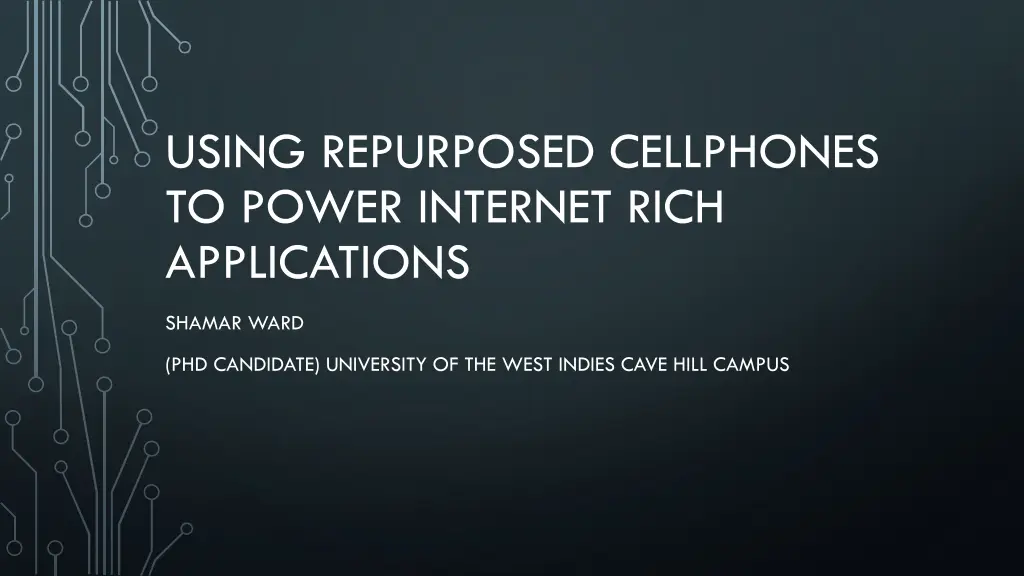
Repurposed Cellphones for Smart Applications in the Caribbean
"Explore Shamar Ward's innovative approach of repurposing cellphones to power internet-rich applications in the Caribbean, reducing costs and environmental impact. Discover how this model addresses the challenges of IoT device importation and promotes sustainability. Learn about practical examples like the door indicator and Wi-Fi monitoring systems developed using old cellphones. Join the movement towards efficient technology utilization and environmental consciousness."
Download Presentation

Please find below an Image/Link to download the presentation.
The content on the website is provided AS IS for your information and personal use only. It may not be sold, licensed, or shared on other websites without obtaining consent from the author. If you encounter any issues during the download, it is possible that the publisher has removed the file from their server.
You are allowed to download the files provided on this website for personal or commercial use, subject to the condition that they are used lawfully. All files are the property of their respective owners.
The content on the website is provided AS IS for your information and personal use only. It may not be sold, licensed, or shared on other websites without obtaining consent from the author.
E N D
Presentation Transcript
USING REPURPOSED CELLPHONES TO POWER INTERNET RICH APPLICATIONS SHAMAR WARD (PHD CANDIDATE) UNIVERSITY OF THE WEST INDIES CAVE HILL CAMPUS
ABOUT ME I am currently a P.h.D Student in Computer Science at The University of The West Indies, Cave Hill Campus. I have given multiple talks at the ACM Special Interest Group For University and Colleges Computing Services (SIGUCSS) Conference while developing smart campus applications using repurposed mobile phones. I am currently Barbados` Male Youth Ambassador to CARICOM (CYA). My research interests lie in computerized automation using low-cost devices and personal efficiency systems.
THE PROBLEM Smart applications can assist with various inefficiencies in the Caribbean. Smart applications require an IoT device and/or sensors for data collection. Importation of Sensors and IoT devices can be expensive in developing states due to taxation and transportation cost. Improper disposal of cell phones/devices can have an implication on land fills as well as they contain toxic chemicals in parts such as the screen.
OUR APPROACH TO SOLVING THE PROBLEM By developing a cell phone repurposing model which allows for the reuse of shelved, retired or damaged cell phones. Applying this model reduces the need to import devices to perform IoT task which a cell phone can perform. It also reduces the cost of implementation of projects as shelved, retired or damaged cell phones can be attained for a low cost or can even be donated.
WHAT HAVE WE DONE DOOR INDICATOR An example to how this can be done is shown in the work by Ward et. Al in [1]. We developed a system which allows for students to see how many computers are available for use in the computer lab. Part of the system contains a door indicator which was designed using an old blackberry 8520. The door indicator would allow students to see the lab status without entering the lab its status.
WHAT HAVE WE DONE WI-FI MONITORING Another example was showing in work by Ward et. al. in [2]. Students who study outdoors on campus require Wi-Fi. Students often have to walk around in search of areas with good connectivity. We developed a system to monitor Wi-Fi signal strength and connectivity speeds in study areas. The information was then made available to students via a mobile application. The application reduced the time students took to identify a study area.
WHAT HAVE WE DONE SHUTTLE MONITORING The University of The West Indies Cave Hill Campus (UWICHC) offers a shuttle service to students to locations off campus. Students often are unaware of where the shuttle is and therefore cannot plan their day efficiently. We developed a system which tracks the shuttle as it progresses along the route. Students can access this information in their web browser from any location. This improves the students ability to plan their time.
ICANNS ROLE IN SMART CITIES AND SMART SYSTEMS IN THE CARIBBEAN? The internet provides the Caribbean a base as to which we can perform research and to fuel our innovations. It is also how we showcase the products we have to offer to the wider world. Domain names and proper management of the internet through the internet governance Ecosystem are integral to Caribbean businesses. Caribbean businesses who use smart city services need a web presence to facilitate further information gathering. Youth will be the drivers of the smart city movement, therefore programs such as NEXTGEN are important to give youth a greater understanding and a voice.
FUTURE WORK? Expanding the current cell phone monitoring project to other campuses. Developing other projects powered by repurposed cell phones. Creating an open source movement focusing on repurposing not just cell phones but devices in general.
REFERENCES? [1] Shamar Akio Ward and Mechelle Gittens. 2015. A Real-time Application to Predict and Notify Students about the Present and Future Availability of Workspaces on a University Campus. In Proceedings of the 2015 ACM Annual Conference on SIGUCCS (SIGUCCS '15). ACM, New York, NY, USA, 67-74. DOI=http://dx.doi.org/10.1145/2815546.2815563 [2] Shamar A. Ward and Mechelle Gittens. 2016. Monitoring and Analyzing Wi-Fi Availability and Performance on a University Campus Using Recycled Cell Phones to Aid Students in Selecting Study Areas. In Proceedings of the 2016 ACM on SIGUCCS Annual Conference (SIGUCCS '16). ACM, New York, NY, USA, 147-152. DOI: https://doi.org/10.1145/2974927.2974929
